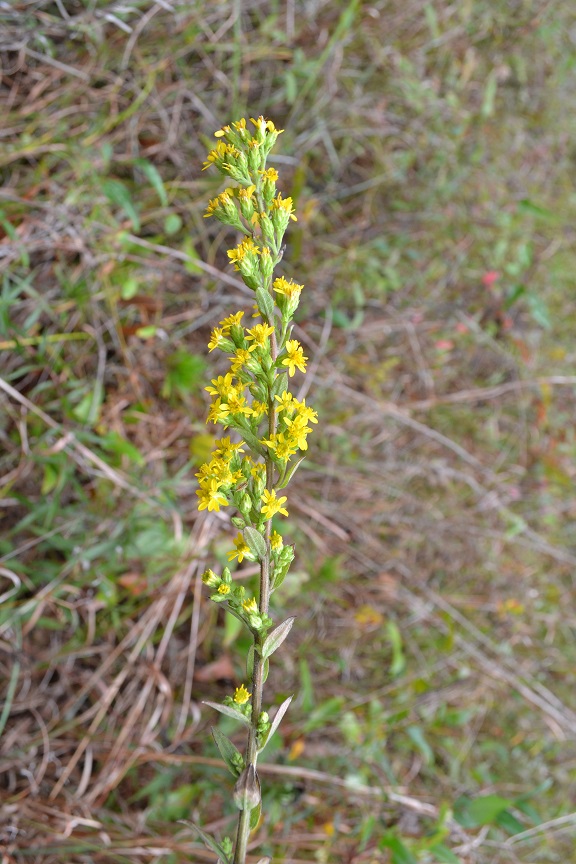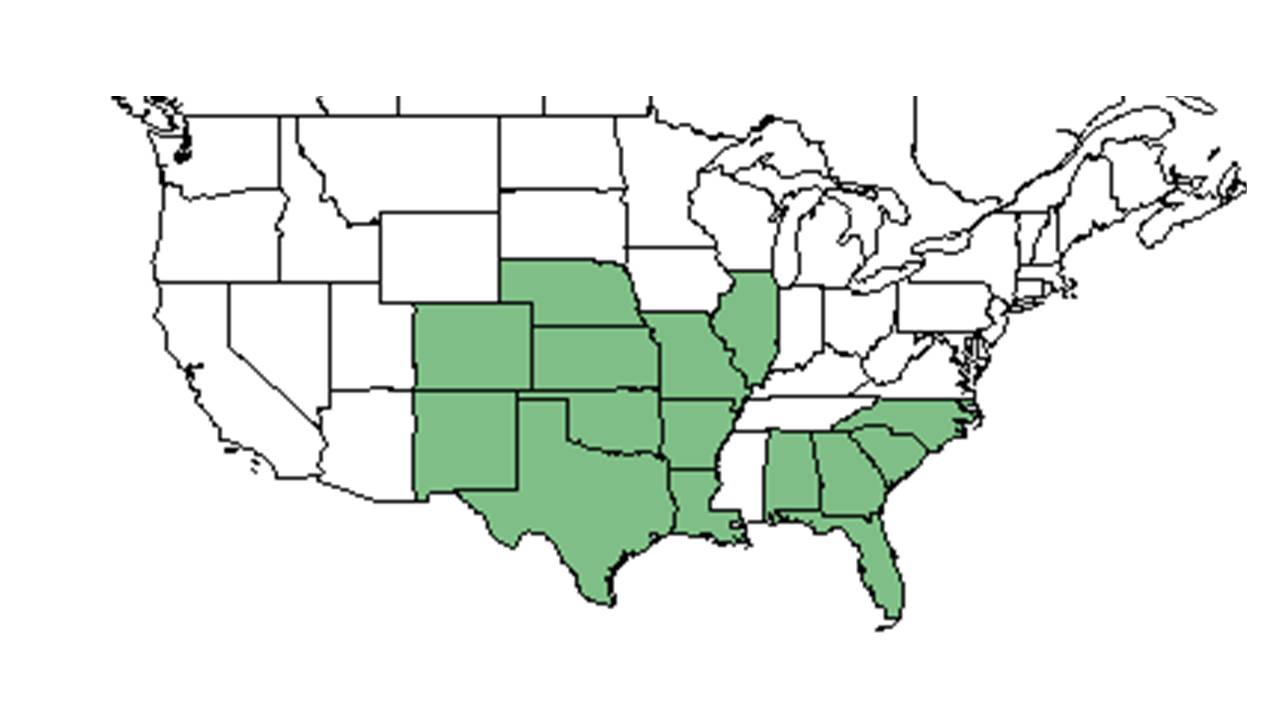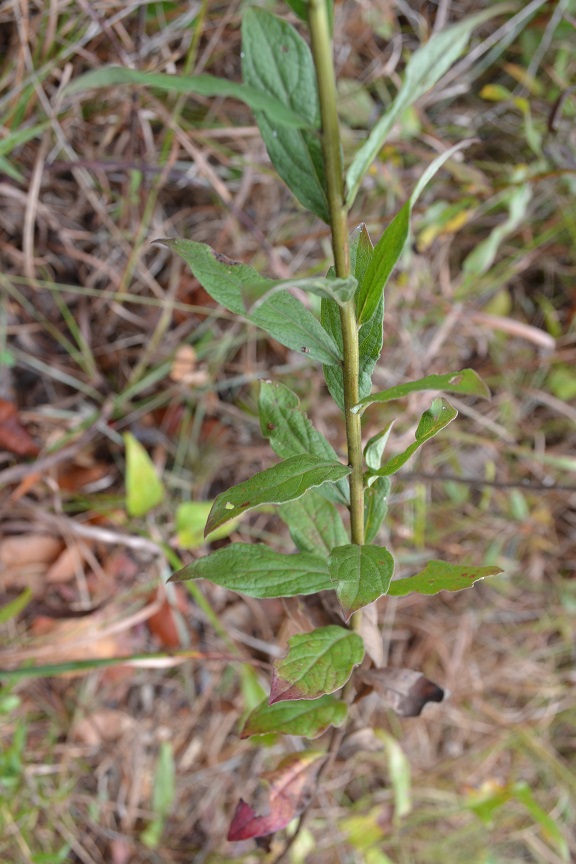Difference between revisions of "Solidago petiolaris"
HaleighJoM (talk | contribs) (→Ecology) |
|||
| (8 intermediate revisions by 3 users not shown) | |||
| Line 20: | Line 20: | ||
Common name: Downy ragged goldenrod | Common name: Downy ragged goldenrod | ||
==Taxonomic notes== | ==Taxonomic notes== | ||
| − | Synonym: | + | Synonym: ''S. milleriana'' Mackenzie; ''S. harperi'' Mackenzie in Small |
| + | |||
| + | Varieties: ''Solidago petiolaris'' Aiton var. ''petiolaris'' | ||
==Description== | ==Description== | ||
| Line 29: | Line 31: | ||
==Ecology== | ==Ecology== | ||
===Habitat=== <!--Natural communities, human disturbed habitats, topography, hydrology, soils, light, fire regime requirements for removal of competition, etc.--> | ===Habitat=== <!--Natural communities, human disturbed habitats, topography, hydrology, soils, light, fire regime requirements for removal of competition, etc.--> | ||
| − | In the Coastal Plain in Florida, ''S. petiolaris'' has been found in open mixed hardwood remnant; mixed second growth hardwood woodland on slopes of sand ridge; moist sandy loam of oak-pine woods; longleaf pine-turkey oak sand ridge; open, upland, oak-hickory woodland; wooded upper rim of steephead; borders of mixed forests; pine-oak-hickory woods; scrub course; and in shaded pine-oak woods. <ref name="FSU Herbarium">Florida State University Robert K. Godfrey Herbarium database. URL: [http://herbarium.bio.fsu.edu http://herbarium.bio.fsu.edu]. Last accessed: July 2015. Collectors: Loran C. Anderson, Richard S. Mitchell, Robert K. Godfrey, Angus Gholson, R. Kral, Andre F. Clewell, Angela M. Reid, K. M. Robertson, Billie Bailey, Cindi Stewart, MacClendons. States and Counties: Florida: Jackson, Jefferson, Leon, Liberty, Okaloosa, Walton. Compiled by Tall Timbers Research Station and Land Conservancy.</ref> In disturbed habitats, it has been found in campgrounds, picnic areas, and roadsides. Soil types include sandy loam, loamy sand and loamy soil. <ref name="FSU Herbarium"/> Associated species include ''Solidago auriculata, Verbesina virginica, Aster'' and ''Desmodium.'' <ref name="FSU Herbarium"/> | + | In the Coastal Plain in Florida, ''S. petiolaris'' has been found in open mixed hardwood remnant; mixed second growth hardwood woodland on slopes of sand ridge; moist sandy loam of oak-pine woods; longleaf pine-turkey oak sand ridge; open, upland, oak-hickory woodland; wooded upper rim of steephead; borders of mixed forests; pine-oak-hickory woods; scrub course; and in shaded pine-oak woods.<ref name="FSU Herbarium">Florida State University Robert K. Godfrey Herbarium database. URL: [http://herbarium.bio.fsu.edu http://herbarium.bio.fsu.edu]. Last accessed: July 2015. Collectors: Loran C. Anderson, Richard S. Mitchell, Robert K. Godfrey, Angus Gholson, R. Kral, Andre F. Clewell, Angela M. Reid, K. M. Robertson, Billie Bailey, Cindi Stewart, MacClendons. States and Counties: Florida: Jackson, Jefferson, Leon, Liberty, Okaloosa, Walton. Compiled by Tall Timbers Research Station and Land Conservancy.</ref> In disturbed habitats, it has been found in campgrounds, picnic areas, and roadsides. Soil types include sandy loam, loamy sand and loamy soil.<ref name="FSU Herbarium"/> |
| + | |||
| + | Associated species include ''[[Solidago auriculata]], [[Verbesina virginica]], Aster'' and ''Desmodium.''<ref name="FSU Herbarium"/> | ||
===Phenology=== <!--Timing off flowering, fruiting, seed dispersal, and environmental triggers. Cite PanFlora website if appropriate: http://www.gilnelson.com/PanFlora/ --> | ===Phenology=== <!--Timing off flowering, fruiting, seed dispersal, and environmental triggers. Cite PanFlora website if appropriate: http://www.gilnelson.com/PanFlora/ --> | ||
| − | It has been recorded flowering and fruiting May, September, October and November. <ref name="FSU Herbarium"/> | + | It has been recorded flowering and fruiting May, September, October and November.<ref name="FSU Herbarium"/> |
<!--===Seed dispersal===--> | <!--===Seed dispersal===--> | ||
<!--===Seed bank and germination===--> | <!--===Seed bank and germination===--> | ||
| − | + | ||
| − | <!--===Pollination===--> | + | ===Fire ecology===<!--Fire tolerance, fire dependence, adaptive fire responses--> |
| − | <!--=== | + | Populations of ''Solidago petiolaris'' have been known to persist through repeated annual burning.<ref>Platt, W.J., R. Carter, G. Nelson, W. Baker, S. Hermann, J. Kane, L. Anderson, M. Smith, K. Robertson. 2021. Unpublished species list of Wade Tract old-growth longleaf pine savanna, Thomasville, Georgia.</ref> |
| + | <!--===Pollination ===--> | ||
| + | <!--===Herbivory and toxicology===<!--Common herbivores, granivory, insect hosting, poisonous chemicals, allelopathy, etc--> | ||
<!--===Diseases and parasites===--> | <!--===Diseases and parasites===--> | ||
| − | ==Conservation and | + | |
| − | == | + | ==Conservation, cultivation, and restoration== |
| + | |||
| + | ==Cultural use== | ||
| + | |||
==Photo Gallery== | ==Photo Gallery== | ||
<gallery widths=180px> | <gallery widths=180px> | ||
Latest revision as of 17:22, 15 July 2022
| Solidago petiolaris | |
|---|---|

| |
| Photo by Kevin Robertson | |
| Scientific classification | |
| Kingdom: | Plantae |
| Division: | Magnoliophyta – Flowering plants |
| Class: | Magnoliopsida – Dicotyledons |
| Order: | Asterales |
| Family: | Asteraceae ⁄ Compositae |
| Genus: | Solidago |
| Species: | S. petiolaris |
| Binomial name | |
| Solidago petiolaris Aiton | |

| |
| Natural range of Solidago petiolaris from USDA NRCS Plants Database. | |
Common name: Downy ragged goldenrod
Contents
Taxonomic notes
Synonym: S. milleriana Mackenzie; S. harperi Mackenzie in Small
Varieties: Solidago petiolaris Aiton var. petiolaris
Description
A description of Solidago petiolaris is provided in The Flora of North America.
Distribution
Ecology
Habitat
In the Coastal Plain in Florida, S. petiolaris has been found in open mixed hardwood remnant; mixed second growth hardwood woodland on slopes of sand ridge; moist sandy loam of oak-pine woods; longleaf pine-turkey oak sand ridge; open, upland, oak-hickory woodland; wooded upper rim of steephead; borders of mixed forests; pine-oak-hickory woods; scrub course; and in shaded pine-oak woods.[1] In disturbed habitats, it has been found in campgrounds, picnic areas, and roadsides. Soil types include sandy loam, loamy sand and loamy soil.[1]
Associated species include Solidago auriculata, Verbesina virginica, Aster and Desmodium.[1]
Phenology
It has been recorded flowering and fruiting May, September, October and November.[1]
Fire ecology
Populations of Solidago petiolaris have been known to persist through repeated annual burning.[2]
Conservation, cultivation, and restoration
Cultural use
Photo Gallery
References and notes
- ↑ 1.0 1.1 1.2 1.3 Florida State University Robert K. Godfrey Herbarium database. URL: http://herbarium.bio.fsu.edu. Last accessed: July 2015. Collectors: Loran C. Anderson, Richard S. Mitchell, Robert K. Godfrey, Angus Gholson, R. Kral, Andre F. Clewell, Angela M. Reid, K. M. Robertson, Billie Bailey, Cindi Stewart, MacClendons. States and Counties: Florida: Jackson, Jefferson, Leon, Liberty, Okaloosa, Walton. Compiled by Tall Timbers Research Station and Land Conservancy.
- ↑ Platt, W.J., R. Carter, G. Nelson, W. Baker, S. Hermann, J. Kane, L. Anderson, M. Smith, K. Robertson. 2021. Unpublished species list of Wade Tract old-growth longleaf pine savanna, Thomasville, Georgia.
